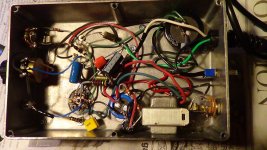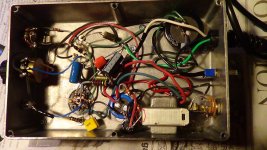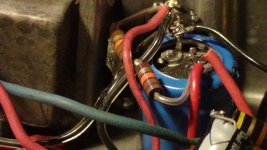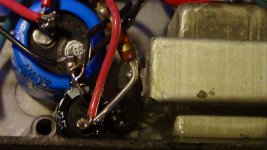I have an old Red Iron Lil Mo' amp, which is a 1 watt point-to-point wired tube amp. I just changed the tubes, but it still hums a lot (120 Hz) and sounds very muffled, not at all what I would expect, based on Youtube videos of other Red Iron amps and my experience with other low power tube amps. Also it seems like it should be a bit louder - I know 1 watt is not all that much. It definitely shouldn't hum that much.
I suspect that the filter cap is bad. Is that is the most likely cause? Is there a way to check, other than just replacing the cap?
I suspect that the filter cap is bad. Is that is the most likely cause? Is there a way to check, other than just replacing the cap?
Attachments
I suspect that the filter cap is bad. Is that is the most likely cause? Is there a way to check, other than just replacing the cap?
A schematic would make things easier.
This is a 12A_7 and 6AQ5 amp with DC heater supply?
What test gear do you have?
Not the cause of your hum, and it may be an optical illusion in the pic, but I'd have a look at moving that resistor next to the (output?) transformer a bit, while you have the amp opened up. Is that clear insulation on the resistor lead?
(Geez:$429 - modern 'P2P wiring' 😱..)
Attachments
Hi,
I would replace the blue capacitor. It is to time to replace those old electrolytic capacitors. Just a thought.
I would replace the blue capacitor. It is to time to replace those old electrolytic capacitors. Just a thought.
I suspect that the filter cap is bad. Is that is the most likely cause? Is there a way to check, other than just replacing the cap?
Tack solder another similar cap in parallel with the existing suspect one. Make sure the polarity is right,
and that the leads are not touching anything else. It'll be clear when you apply power whether the problem is gone.
Looks like there could also be a short between the case of what I believe is the output transformer and a resistor in the power supply. Could be an optical illusion.
It certainly has a thrown together look to it. Does it have a fuse? I assume it has a power transformer.
It certainly has a thrown together look to it. Does it have a fuse? I assume it has a power transformer.
It certainly has a thrown together look to it. Does it have a fuse? I assume it has a power transformer.
Amazing....
I thought electrical equipment needed a UL sticker or had to at least meet some sort of code requirement to be sold in the US?
I don't see a fuse in there. I do see the HV secondary wires and the 120v primary conductors going through non-grommeted holes to the top of the chassis where the PT must be mounted in this version.
The transformer we're looking at is the output transformer - you can see the connections to B+ and the power tube plate.
From the builder's website:
And this is the 'new and improved' version??After working at Kendrick Amplifiers, I found that most problems were the result of inadequate build-quality at the foundation.
Hot melt glue some caps into a chassis and start solderin' !
I suspect that the filter cap is bad. Is that is the most likely cause? Is there a way to check, other than just replacing the cap?
It could be hum from the power supply, or it could be a grounding problem.
Since it looks like the chassis is the 'ground plane', I'd check that the input and output jacks are making good tight contact with the chassis. It will be tough to loosen them much, but backing off the nut and pulling folded sandpaper between the jack and the inside of the chassis, then re-tightening with a socket driver (gently) might help.
If you have a scope and/or ESR meter those could help in troubleshooting, but they're not common in the average workshop.
In a different amp, just 'shotgunning' the electrolytic caps would be the easiest option, but in the Lil Mo it would mean a lot of disassembly and reassembly, since the caps are used as part of the framework for the wiring.
Just to be clear, you have three suspects for cap problems: the large black 4700uF 50v cap on the heater supply (upper right in the pic), the smaller blue 400v cap with the power supply wiring attached (to the left of the output transformer) and the filter cap for the preamp (the black cap with the grey stripe).
You could try wiring up an appropriate size (and voltage rating) cap with wire leads and either tack solder (as already suggested) or attach alligator clips and connect in parallel with the existing caps. Though this doesn't always cure the problem, it should give you an idea of where to focus your attention.
A schematic would make things easier.
This is a 12A_7 and 6AQ5 amp with DC heater supply?
What test gear do you have?
Not the cause of your hum, and it may be an optical illusion in the pic, but I'd have a look at moving that resistor next to the (output?) transformer a bit, while you have the amp opened up. Is that clear insulation on the resistor lead?
(Geez:$429 - modern 'P2P wiring' 😱..)
Yes, it is a 12AX7 and a 6AQ5.
I don't have a scope, just a multimeter.
That transformer is the output transformer and there does seem to be some goop in there. See pic.
The power transformer is on top. I think this may have been some sort of prototype or early version, as it does not look quite like the picture on the Red Iron website (which does not show a transformer on top). It does not have a fuse.
It might be best to just replace the three suspect caps, as this amp has been sitting around for a few years (10?) without being used. I don't remember what I paid for it, but I'm sure it was considerably less than $429.
Attachments
It might be best to just replace the three suspect caps, as this amp has been sitting around for a few years (10?) without being used.
Perhaps, but removing and replacing those caps will be a lot of work.
Are you sure you've eliminated the 'bad tube' and 'loose grounds' possibilities completely?
Thanks for those close-up pics. I'd missed the 4th cap tucked in between the blue cap and the output transformer.
If you do re-cap it, it will be almost a complete rebuild. (It might be a chance to replace some of those carbon resistors with metal types...)
BTW, while thinking along those lines, you could try (with power off) measuring the resistance of the resistors with your meter and comparing to the markings.
With power on, you could measure some voltages to see what the tubes are getting.
Black meter lead connected to ground. DC volts. Voltages at plates (Pins 1 and 6 of the 12A_7 tube and at pin 5 of the 6AQ5). Voltages at cathodes (Pins 1,3 of 12A_7 and pin 2 of 6AQ5). If you have some clip leads it will be safer than probing around with the power on. Remember that you don't need the probe right on the pin if there is a bare conductor soldered to the pin that you can access.
Last edited:
.... there does seem to be some goop in there. See pic.
......
My guess would be a heavy hand with the hot melt glue gun, to 'lock stuff in place'.😱
Are you sure you've eliminated the 'bad tube' and 'loose grounds' possibilities completely?
Not entirely, but I have replaced the tubes and have sanded under the jacks to make sure they are making good contact. Also sanded at the main grounding lug.
The 12AX7 is showing a voltage of 93 on anode #1 and 0.8 on cathode #1. Similarly, 91 on anode #2 and 0.9 on cathode #2.With power on, you could measure some voltages to see what the tubes are getting.
Black meter lead connected to ground. DC volts. Voltages at plates (Pins 1 and 6 of the 12A_7 tube and at pin 5 of the 6AQ5). Voltages at cathodes (Pins 1,3 of 12A_7 and pin 2 of 6AQ5). If you have some clip leads it will be safer than probing around with the power on. Remember that you don't need the probe right on the pin if there is a bare conductor soldered to the pin that you can access.
The 6AQ5 shows 179 on the plate and 9.2 on the cathode.
That seems like a pretty low voltage on the 12AX7 and probably why this amp distorts so early.
Do the voltages tell you anything else?
- Status
- Not open for further replies.
- Home
- Live Sound
- Instruments and Amps
- 1 watt amp with too much hum



